
|
Appearing in the morning sky again. Brightening rapidly. Now it is so bright as 8.4 mag (Aug. 24, Marco Goiato). It is expected to brighten up to 5 mag in autumn. In the Southern Hemisphere, it keeps observable until mid October including the highlight. In the Northern Hemisphere, it keeps observable in the morning low sky until early September when it brightens up to 6 mag.
Date(TT) R.A. (2000) Decl. Delta r Elong. m1 Best Time(A, h)
Aug. 30 6 59.06 0 14.2 0.917 0.877 53 7.7 4:02 (284, 20)
Sept. 6 7 42.17 -8 7.6 0.678 0.784 50 6.6 4:09 (289, 13)
|

|
Now it is bright as 7.0 mag (Aug. 27, Maik Meyer). In the Northern Hemisphere, it will be observable in excellent condition after this. In the Southern Hemisphere, it will be observable soon, and it keeps observable in good condition in the evening sky after that.
Date(TT) R.A. (2000) Decl. Delta r Elong. m1 Best Time(A, h)
Aug. 30 22 7.00 60 42.7 0.566 1.315 109 6.7 23:18 (180, 65)
Sept. 6 20 20.98 44 39.0 0.634 1.420 117 7.3 21:15 (180, 81)
|

|
It brightened up to 7.9 mag until early July (July 3, Marek Biely). The brightening is somewhat slow, but it will brighten up to 6-7 mag in autumn. It will appear in the morning sky soon. It will be observable in good condition in the Southern Hemisphere after this. But it keeps low in the Northern Hemisphere.
Date(TT) R.A. (2000) Decl. Delta r Elong. m1 Best Time(A, h)
Aug. 30 9 5.10 7 51.1 1.926 1.055 21 7.1 4:02 (259, -2)
Sept. 6 8 59.99 4 43.6 1.823 1.066 29 7.0 4:09 (267, 4)
|
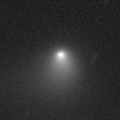
|
Now it is bright as 10.0 mag (Aug. 19, Marco Goiato). The brightening is somewhat slow, but it is expected to brighten up to 8.5 mag and to be observable in excellent condition from summer to autumn in the Southern Hemisphere. It keeps observable in good condition until early November in the Southern Hemisphere. In the Northern Hemisphere, it is not observable now. It is observable only in the evening low sky from late September to mid November. But it will be observable in excellent condition after 2015 January while the comet will be fading. It will pass extremely close to Mars on Oct. 19.
Date(TT) R.A. (2000) Decl. Delta r Elong. m1 Best Time(A, h)
Aug. 30 0 35.65 -72 19.8 0.914 1.616 114 8.6 2:11 ( 0,-17)
Sept. 6 21 10.00 -73 31.2 0.891 1.569 111 8.4 21:54 ( 0,-18)
|

|
It brightened rapidly in outburst in mid October in 2013. Now it is bright as 10.5 mag (Aug. 20, Marco Goiato). It will be fading gradually after this. In the Southern Hemisphere, it keeps observable in good condition for a long time until the comet fades out. In the Northern Hemisphere, it keeps extremely low after this.
Date(TT) R.A. (2000) Decl. Delta r Elong. m1 Best Time(A, h)
Aug. 30 21 52.19 -50 42.4 2.049 2.877 137 10.7 23:17 ( 0, 4)
Sept. 6 21 46.46 -51 15.0 2.163 2.944 132 11.0 22:44 ( 0, 4)
|

|
It brightened rapidly as expected, however, it reached only up to 11.8 mag at best, fainter than expected by 2 mag (Aug. 19, Ken-ichi Kadota). It will never be observable after this.
Date(TT) R.A. (2000) Decl. Delta r Elong. m1 Best Time(A, h)
Aug. 30 9 43.72 15 31.3 1.530 0.596 13 13.0 4:02 (247, -5)
Sept. 6 10 22.85 13 12.3 1.636 0.673 10 14.1 4:09 (248, -7)
|
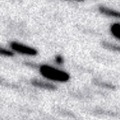
|
Appearing in the morning sky again. Now it is 14.4 mag (July 1, Jean-Francois Soulier). It keeps observable for a long time after this while the comet will be fading gradually.
Date(TT) R.A. (2000) Decl. Delta r Elong. m1 Best Time(A, h)
Aug. 30 7 39.96 14 48.9 2.507 1.889 42 13.3 4:02 (265, 19)
Sept. 6 7 55.43 13 52.3 2.491 1.922 45 13.4 4:09 (269, 23)
|
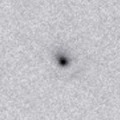
|
Appearing in the morning sky. In the Northern Hemisphere, it will be observable at 12-13 mag in excellent condition from 2014 summer to 2015 spring. In the Southern Hemisphere, it will locate low around the highlight.
Date(TT) R.A. (2000) Decl. Delta r Elong. m1 Best Time(A, h)
Aug. 30 7 32.49 25 58.0 2.621 2.049 45 13.5 4:02 (256, 26)
Sept. 6 7 50.35 25 41.2 2.558 2.036 48 13.4 4:09 (258, 30)
|

|
Now it is 12.8 mag (Aug. 19, Marco Goiato). It keeps bright as 13-14 mag for a long time from 2013 to 2014.
Date(TT) R.A. (2000) Decl. Delta r Elong. m1 Best Time(A, h)
Aug. 30 20 31.56 -30 53.4 2.274 3.151 144 13.8 21:57 ( 0, 24)
Sept. 6 20 29.17 -30 47.0 2.340 3.159 137 13.8 21:27 ( 0, 24)
|

|
No bright outburst was reported in July and August. It will be unobservable in mid September in the Northern Hemisphere, or in late October in the Southern Hemisphere.
Date(TT) R.A. (2000) Decl. Delta r Elong. m1 Best Time(A, h)
Aug. 30 15 27.61 -27 35.6 6.206 6.115 80 13.9 19:58 ( 41, 14)
Sept. 6 15 30.83 -27 35.8 6.311 6.113 74 13.9 19:47 ( 43, 12)
|

|
It brightened very rapidly, and brightened up to 9.4 mag in early July (July 4, Maik Meyer). However, it will be fading rapidly after this. It has already faded down to 11.9 mag (Aug. 27, Uwe Pilz), and 14.5 mag (Aug. 28, Jakub Cerny). It keeps observable until early September in the Southern Hemisphere, or until late September in the Northern Hemisphere.
Date(TT) R.A. (2000) Decl. Delta r Elong. m1 Best Time(A, h)
Aug. 30 13 57.85 15 35.2 1.799 1.394 50 14.1 19:58 ( 91, 26)
Sept. 6 13 58.18 14 19.4 1.992 1.463 44 14.6 19:47 ( 92, 22)
|

|
Now it is 13.6 mag (Aug. 27, Sandor Szabo). It keeps bright at 13-14 mag for a long time until 2014.
Date(TT) R.A. (2000) Decl. Delta r Elong. m1 Best Time(A, h)
Aug. 30 18 29.21 -5 35.3 6.189 6.745 119 14.4 19:58 ( 1, 49)
Sept. 6 18 26.24 -6 22.9 6.317 6.769 112 14.5 19:47 ( 8, 48)
|

|
New bright comet. Now it is 14.6 mag (Aug. 23, iTelescope Observatory, Siding Spring). It will approach to the earth in December and January, and it is expected to brighten up to 8 mag. In the Southern Hemisphere, it keeps observable in excellent condition until late January. In the Northern Hemisphere, it keeps extremely low until mid December. But after that, it will be observable in excellent condition.
Date(TT) R.A. (2000) Decl. Delta r Elong. m1 Best Time(A, h)
Aug. 30 7 6.55 -41 32.2 2.675 2.502 69 14.6 4:02 (315, -9)
Sept. 6 7 16.42 -41 30.2 2.585 2.427 69 14.4 4:09 (318, -5)
|

|
New bright comet. Now it is 14.2 mag (Aug. 28, Jakub Cerny). It is observable at 14 mag in excellent condition until November.
Date(TT) R.A. (2000) Decl. Delta r Elong. m1 Best Time(A, h)
Aug. 30 0 1.28 -3 11.4 1.309 2.274 157 14.4 1:30 ( 0, 52)
Sept. 6 23 59.48 -3 50.4 1.300 2.287 164 14.5 1:01 ( 0, 51)
|

|
Now it is 14.2 mag (Aug. 27, Jakub Cerny). It keeps 13-14 mag and observable in good condition in the Northern Hemisphere for a long time from 2013 to 2014. In the Southern Hemisphere, it is not observable until 2014 autumn.
Date(TT) R.A. (2000) Decl. Delta r Elong. m1 Best Time(A, h)
Aug. 30 0 9.20 51 26.4 3.576 4.118 115 14.6 1:39 (180, 73)
Sept. 6 23 56.17 50 14.2 3.533 4.153 121 14.6 0:58 (180, 75)
|
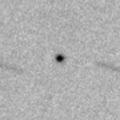
|
Now it is 14.2 mag (Aug. 28, Jakub Cerny). Getting brighter than originally expected, and it is already visible visually. It is expected to brighten up to 4 mag from autumn to winter in 2015. It is observable in good condition in the Southern Hemisphere until the highlight, or in the Northern Hemisphere after the highlight.
Date(TT) R.A. (2000) Decl. Delta r Elong. m1 Best Time(A, h)
Aug. 30 23 33.59 -19 34.7 4.716 5.685 161 14.7 1:03 ( 0, 36)
Sept. 6 23 27.25 -20 30.0 4.641 5.619 164 14.6 0:29 ( 0, 35)
|
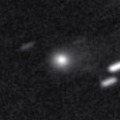
|
Now it is 14.9 mag (Aug. 12, Taras Prystavski). It is expected to brighten up to 13 mag and to be observable in good condition in 2015. It will be unobservable temporarily after mid September.
Date(TT) R.A. (2000) Decl. Delta r Elong. m1 Best Time(A, h)
Aug. 30 14 14.09 -4 3.7 4.461 3.998 56 14.8 19:58 ( 71, 18)
Sept. 6 14 20.90 -4 43.8 4.508 3.967 51 14.8 19:47 ( 72, 16)
|

|
It passed only 0.4 A.U. from the earth, and 0.8 A.U. from the sun in November and December in 2013, and brightened up to 4.7 mag (Nov. 28, Juan Jose Gonzalez). Now it is 16.2 mag (Aug. 12, Taras Prystavski). It keeps observable until early September in the Northern Hemisphere, or early November in the Southern Hemisphere.
Date(TT) R.A. (2000) Decl. Delta r Elong. m1 Best Time(A, h)
Aug. 30 15 40.71 -30 20.3 3.695 3.722 83 14.8 19:58 ( 37, 13)
Sept. 6 15 44.37 -30 46.7 3.881 3.799 77 15.0 19:47 ( 39, 11)
|
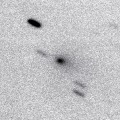
|
It brightened up to 2 mag by unusual major outburst in 2007. It is coming back now. Now it is 14.4 mag (Aug. 28, Jakub Cerny). In the Northern Hemisphere, it keeps observable until it fades out in 2015. In the Southern Hemisphere, it keeps extremely low after this.
Date(TT) R.A. (2000) Decl. Delta r Elong. m1 Best Time(A, h)
Aug. 30 4 35.57 41 58.3 2.270 2.375 83 14.9 4:02 (244, 65)
Sept. 6 4 45.27 43 3.9 2.218 2.400 87 15.0 4:09 (240, 69)
|

|
It brightened up to 11-12 mag in 2012. Now it is 14.9 mag (Aug. 12, Taras Prystavski). It is not observable now in the Northern Hemisphere. It will be unobservable soon also in the Southern Hemisphere. It will be observable at 15 mag in good condition again in 2015.
Date(TT) R.A. (2000) Decl. Delta r Elong. m1 Best Time(A, h)
Aug. 30 11 54.31 -7 6.6 8.998 8.103 26 14.9 19:58 ( 89,-12)
Sept. 6 11 55.82 -7 18.2 9.079 8.140 20 15.0 19:47 ( 91,-15)
|

|
New bright comet. Now it is 15.4 mag (July 11, Taras Prystavski). It keeps 15 mag for a long time from 2014 to 2015. It is observable in excellent condition in 2014 in the Southern Hemisphere, or in 2015 in the Northern Hemisphere.
Date(TT) R.A. (2000) Decl. Delta r Elong. m1 Best Time(A, h)
Aug. 30 1 41.98 -36 9.7 3.525 4.237 129 15.0 3:11 ( 0, 19)
Sept. 6 1 36.18 -36 15.1 3.459 4.214 133 14.9 2:38 ( 0, 19)
|

|
Big asteroid discovered in 1906. It suddenly showed the cometary activity on Dec. 11, 2010, probably due to an impact of a small object. It has already turned to be stellar.
Date(TT) R.A. (2000) Decl. Delta r Elong. m1 Best Time(A, h)
Aug. 30 4 46.22 18 16.6 3.351 3.395 83 15.1 4:02 (291, 56)
Sept. 6 4 50.46 18 32.0 3.251 3.397 89 15.0 4:09 (299, 62)
|
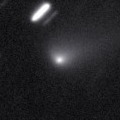
|
It brightened up to 12-13 mag from April to May. Now it is fading. It has already faded down to 15.2 mag (Aug. 12, Taras Prystavski). It will be unobservable in late October.
Date(TT) R.A. (2000) Decl. Delta r Elong. m1 Best Time(A, h)
Aug. 30 15 9.51 -14 29.6 2.823 2.699 72 15.4 19:58 ( 53, 21)
Sept. 6 15 19.99 -15 10.6 2.919 2.717 68 15.5 19:47 ( 54, 20)
|
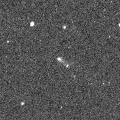
|
Now it is 14.2 mag (Aug. 28, Jakub Cerny). First return of a new periodic comet which brightened up to 13 mag in 2007. It was expected to brighten up to 13 mag again and observable in good condition from summer to autumn in 2014. But actually, it is fainter than expected.
Date(TT) R.A. (2000) Decl. Delta r Elong. m1 Best Time(A, h)
Aug. 30 23 45.51 -9 54.2 1.308 2.290 161 15.6 1:15 ( 0, 45)
Sept. 6 23 42.75 -11 9.2 1.294 2.290 168 15.5 0:44 ( 0, 44)
|

|
It brightened rapidly, and reached up to 14.0 mag (Mar. 28, Sandor Szabo). Now it is 15.2 mag (July 19, Taras Prystavski). It keeps observable in good condition until mid October in the Southern Hemisphere. In the Northern Hemisphere, it locates extremely low and too hard to observe.
Date(TT) R.A. (2000) Decl. Delta r Elong. m1 Best Time(A, h)
Aug. 30 13 40.70 -16 19.2 2.588 2.140 53 15.7 19:58 ( 67, 4)
Sept. 6 13 57.83 -16 33.8 2.682 2.178 50 15.9 19:47 ( 66, 4)
|

|
Now it is 16.8 mag (July 28, Hidetaka Sato). It will brighten very rapidly after this. It is expected to be observable at 14.5 mag in excellent condition from October to December.
Date(TT) R.A. (2000) Decl. Delta r Elong. m1 Best Time(A, h)
Aug. 30 4 0.96 12 24.8 1.363 1.774 95 15.9 4:02 (313, 60)
Sept. 6 4 14.47 13 41.7 1.292 1.757 98 15.7 4:09 (321, 64)
|
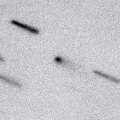
|
Now it is 15.8 mag (July 20, Toshiyuki Takahashi). In the Northern Hemisphere, it will be getting higher gradually after this, and keeps observable in good condition while the comet will be fading gradually. In the Southern Hemisphere, it keeps extremely low.
Date(TT) R.A. (2000) Decl. Delta r Elong. m1 Best Time(A, h)
Aug. 30 6 54.65 28 50.0 1.963 1.605 54 15.9 4:02 (257, 35)
Sept. 6 7 15.71 29 34.7 1.940 1.626 56 16.1 4:09 (258, 38)
|
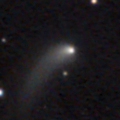
|
Now it is 15.1 mag (Aug. 27, Sandor Szabo). It will be fading after this. In the Northern Hemisphere, it keeps observable until October when the comet will fade down to 17.5 mag. It will never be observable in the Southern Hemisphere.
Date(TT) R.A. (2000) Decl. Delta r Elong. m1 Best Time(A, h)
Aug. 30 13 44.20 36 21.2 2.865 2.366 51 16.0 19:58 (114, 33)
Sept. 6 13 57.91 33 21.0 2.958 2.427 49 16.2 19:47 (111, 31)
|
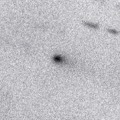
|
Now it is 15.7 mag (July 29, Taras Prystavski). It will be fading gradually after this. It keeps observable until next February when the comet will be fainter than 18 mag. In the Northern Hemispehre, it keeps observable in excellent condition. It locates somewhat low in the Southern Hemisphere.
Date(TT) R.A. (2000) Decl. Delta r Elong. m1 Best Time(A, h)
Aug. 30 6 44.83 19 29.7 2.051 1.704 55 16.0 4:02 (268, 33)
Sept. 6 7 1.05 19 3.1 2.034 1.740 58 16.1 4:09 (271, 36)
|
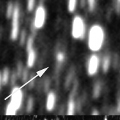
|
Now it is 16.2 mag (Aug. 24, Jean-Francois Viens). Distant object, but it keeps observable at 14 mag for a long time from 2015 to 2016.
Date(TT) R.A. (2000) Decl. Delta r Elong. m1 Best Time(A, h)
Aug. 30 18 53.13 -4 1.0 5.983 6.618 125 16.1 20:19 ( 0, 51)
Sept. 6 18 52.69 -4 22.9 6.039 6.587 118 16.1 19:51 ( 0, 51)
|
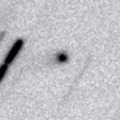
|
Now it is 16.1 mag (July 30, Taras Prystavski). It is expected to brighten up to 14 mag from 2015 to 2016. It is observable in good condition in the Southern Hemisphere. It locates somewhat low in the Northern Hemisphere.
Date(TT) R.A. (2000) Decl. Delta r Elong. m1 Best Time(A, h)
Aug. 30 5 35.56 -20 19.2 5.288 5.185 78 16.3 4:02 (315, 20)
Sept. 6 5 34.45 -20 49.0 5.161 5.152 83 16.2 4:09 (322, 24)
|

|
New comet. Now it is 16.0 mag (Aug. 23, J. Hambsch, E. Bryssinck). It will brighten up to 14.5 mag in November. In the Northern Hemisphere, it keeps observable in good condition until the comet will fade out in next spring. In the Southern Hemisphere, it will be unobservable in late September.
Date(TT) R.A. (2000) Decl. Delta r Elong. m1 Best Time(A, h)
Aug. 30 6 5.29 23 50.3 2.156 1.960 65 16.6 4:02 (269, 43)
Sept. 6 6 13.87 27 0.8 2.004 1.912 70 16.3 4:09 (268, 50)
|
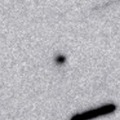
|
Now it is 16.9 mag (July 30, Taras Prystavski). It keeps observable at 15-16 mag for a long time from 2015 to 2016. In the Northern Hemisphere, it is observable in excellent condition. It locates somewhat low in the Southern Hemisphere.
Date(TT) R.A. (2000) Decl. Delta r Elong. m1 Best Time(A, h)
Aug. 30 4 11.25 18 29.6 5.875 5.997 92 16.6 4:02 (301, 63)
Sept. 6 4 11.45 19 3.5 5.736 5.972 98 16.6 4:09 (314, 69)
|

|
It brightened up to 12-13 mag from 2012 to 2013. Now it is fading. But it is bright as 15.7 mag still now (July 11, Toshiyuki Takahashi). It keeps 16-17 mag until autumn, and will be observable in good condition.
Date(TT) R.A. (2000) Decl. Delta r Elong. m1 Best Time(A, h)
Aug. 30 0 56.47 -16 2.7 3.101 3.964 144 16.6 2:25 ( 0, 39)
Sept. 6 0 53.16 -16 37.8 3.076 3.982 150 16.6 1:55 ( 0, 38)
|
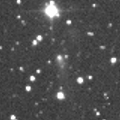
|
It brightened rapidly, and became brighter than originally predicted. Now it is 15.8 mag (Aug. 12, Taras Prystavski). It will be fading after this. It keeps observable until late September in the Northern Hemisphere, or early November in the Southern Hemisphere.
Date(TT) R.A. (2000) Decl. Delta r Elong. m1 Best Time(A, h)
Aug. 30 15 55.21 -25 18.9 4.373 4.412 85 16.8 19:58 ( 37, 19)
Sept. 6 15 59.83 -25 30.1 4.494 4.430 79 16.8 19:47 ( 39, 18)
|
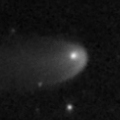
|
Now it is between 15.6 mag (July 7, Taras Prystavski) and 18.2 mag (July 3, K. Hills). It brightened up to 13 mag from 2011 to 2012. It will be fading after this, but it keeps brighter than 18 mag until 2015 spring.
Date(TT) R.A. (2000) Decl. Delta r Elong. m1 Best Time(A, h)
Aug. 30 3 57.05 -4 29.2 8.497 8.720 99 16.9 4:02 (329, 46)
Sept. 6 3 56.34 -4 32.5 8.427 8.755 105 16.9 4:09 (341, 49)
|

|
Now it is 16.8 mag (Aug. 12, Taras Prystavski). It keeps 17 mag for a long time from 2014 to 2015. It is observable in excellent condition in the Northern Hemisphere. It is observable only until mid September in the Southern Hemisphere.
Date(TT) R.A. (2000) Decl. Delta r Elong. m1 Best Time(A, h)
Aug. 30 15 49.84 32 41.1 4.028 3.911 76 16.9 19:58 ( 98, 57)
Sept. 6 15 55.14 32 9.0 4.071 3.901 73 17.0 19:47 ( 98, 54)
|
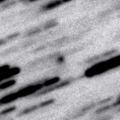
|
Now it is 17.5 mag (June 21, Hidetaka Sato). It will keep 16-17 mag for a long time from 2014 summer to early 2016. It keeps observable in excellent condition until autumn in the Southern Hemisphere. It keeps low in the Northern Hemisphere.
Date(TT) R.A. (2000) Decl. Delta r Elong. m1 Best Time(A, h)
Aug. 30 16 51.11 -23 38.4 2.267 2.605 97 17.0 19:58 ( 26, 27)
Sept. 6 16 57.13 -23 33.1 2.330 2.578 92 17.0 19:47 ( 28, 26)
|

|
New comet. It will approach to the sun down to 0.3 a.u. in 2015 July, and it is expected to be bright. Now it is 16.7 mag (Aug. 22, iTelescope Observatory, Siding Spring). It keeps observable while the comet will be brightening gradually until January when the comet will be 15 mag. The condition is bad after that and it will be hard to observe. But in the Southern Hemisphere, it will be observable after mid July in 2015, and keeps observable while the comet will be fading gradually. In the Northern Hemisphere, it is extremely hard to observe after 2015.
Date(TT) R.A. (2000) Decl. Delta r Elong. m1 Best Time(A, h)
Aug. 30 0 0.98 -27 30.7 3.811 4.728 152 17.2 1:30 ( 0, 28)
Sept. 6 23 54.80 -28 11.0 3.722 4.652 154 17.0 0:57 ( 0, 27)
|
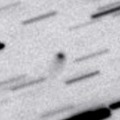
|
Now it is 17.4 mag (June 22, Catalina Sky Survey). It keeps observable at 18 mag for a long time from 2013 to 2016. It keeps locating high in the Northern Hemisphere. It keeps locating very low in the Southern Hemipshere.
Date(TT) R.A. (2000) Decl. Delta r Elong. m1 Best Time(A, h)
Aug. 30 16 55.05 48 13.7 6.439 6.463 86 17.1 19:58 (134, 68)
Sept. 6 16 51.67 47 33.5 6.490 6.464 84 17.2 19:47 (129, 65)
|

|
Now it is 18.7 mag (Aug. 1, A. Klotz, F. Kugel, C. Rinner, J. Nicolas). It keeps observable at 17-18 mag from August to November in excellent condition in the Northern Hemisphere. It locates somewhat low in the Southern Hemisphere.
Date(TT) R.A. (2000) Decl. Delta r Elong. m1 Best Time(A, h)
Aug. 30 5 16.09 21 39.7 1.208 1.383 76 17.3 4:02 (280, 52)
Sept. 6 5 38.84 22 12.1 1.186 1.389 78 17.2 4:09 (281, 55)
|

|
Now it is 17.2 mag (Aug. 24, Jean-Francois Viens). It has brightened in outburst up to 14 mag twice, in 2006 January and 2011 May. It will pass the perihelion in 2015. It keeps observable at 17 mag for a long time after this.
Date(TT) R.A. (2000) Decl. Delta r Elong. m1 Best Time(A, h)
Aug. 30 20 57.09 -14 1.9 4.988 5.926 156 17.2 22:23 ( 0, 41)
Sept. 6 20 55.05 -14 14.9 5.033 5.920 148 17.3 21:53 ( 0, 41)
|

|
Now it is 17.4 mag (Aug. 2, iTelescope Observatory, Siding Spring). It keeps observable at 17-18 mag from summer to winter in excellent condition in the Northern Hemisphere. It locates somewhat low in the Southern Hemisphere.
Date(TT) R.A. (2000) Decl. Delta r Elong. m1 Best Time(A, h)
Aug. 30 5 59.13 18 6.1 2.426 2.228 66 17.3 4:02 (277, 42)
Sept. 6 6 10.72 18 9.9 2.372 2.249 70 17.3 4:09 (280, 46)
|

|
Now it is 17.8 mag (July 27, iTelescope Observatory, Siding Spring). It will brighten up to 15 mag and will be observable in excellent condition from winter to spring.
Date(TT) R.A. (2000) Decl. Delta r Elong. m1 Best Time(A, h)
Aug. 30 23 2.79 -19 1.2 1.004 2.002 167 17.5 0:32 ( 0, 36)
Sept. 6 22 55.69 -19 38.0 0.957 1.953 166 17.3 23:53 ( 0, 35)
|

|
Now it is 17.4 mag (Aug. 5, A. Klotz, F. Kugel, C. Rinner, J. Nicolas). It will brighten up to 15 mag and will be observable in excellent condition from November to February in the Northern Hemisphere. It locates somewhat low in the Southern Hemisphere.
Date(TT) R.A. (2000) Decl. Delta r Elong. m1 Best Time(A, h)
Aug. 30 5 45.34 30 54.1 2.732 2.564 69 17.6 4:02 (262, 50)
Sept. 6 5 56.96 30 53.5 2.641 2.553 73 17.3 4:09 (264, 55)
|
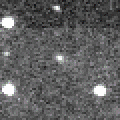
|
Now it is 18.1 mag (July 8, J. Nicolas, A. Klotz, F. Kugel, C. Rinner). It keeps observable at 17-18 mag in good condition from July to October.
Date(TT) R.A. (2000) Decl. Delta r Elong. m1 Best Time(A, h)
Aug. 30 22 6.30 -15 13.3 1.509 2.512 171 17.4 23:31 ( 0, 40)
Sept. 6 22 2.01 -15 7.8 1.521 2.505 163 17.4 23:00 ( 0, 40)
|

|
It will brighten up to 14 mag around the perihelion passage in 2019. In 2014, it will be observable in excellent condition at 17 mag from summer to winter in the Northern Hemisphere. It locates extremely low in the Southern Hemisphere. However, it is so faint as 20.2 mag now, much fainter than this ephemeris by 3 mag (July 27, J. Vinko, R. Szakats, K. Sarneczky).
Date(TT) R.A. (2000) Decl. Delta r Elong. m1 Best Time(A, h)
Aug. 30 3 28.04 34 25.5 12.405 12.582 97 17.5 4:02 (269, 79)
Sept. 6 3 27.70 34 42.2 12.267 12.554 104 17.4 4:09 (272, 86)
|

|
First return of a new periodic comet discovered in 2005. It was expected to be observable at 17 mag for a long time from 2013 to 2014. However, it has not been recovered yet. Actually, it is much fainter than predicted, fainter than 20.5 mag (Aug. 1, Jean-Francois Soulier).
Date(TT) R.A. (2000) Decl. Delta r Elong. m1 Best Time(A, h)
Aug. 30 22 53.46 -11 20.8 2.370 3.377 174 17.4 0:23 ( 0, 44)
Sept. 6 22 49.20 -11 59.7 2.382 3.387 174 17.5 23:47 ( 0, 43)
|

|
It keeps 17.5 mag and will be observable in excellent condition from autumn to winter in the Northern Hemisphere. It locates somewhat low in the Southern Hemisphere. Jean-Francois Soulier reported that actually it is 20.5 mag (Sept. 1), much fainter than predicted.
Date(TT) R.A. (2000) Decl. Delta r Elong. m1 Best Time(A, h)
Aug. 30 5 38.23 26 35.2 1.543 1.549 71 17.8 4:02 (269, 50)
Sept. 6 5 59.03 25 42.9 1.503 1.552 73 17.8 4:09 (272, 52)
|

|
Now it is 19.7 mag (July 30, iTelescope Observatory, Siding Spring). It will brighten up to 9 mag in 2015 spring. But the condition of this apparition is bad. In the Southern Hemisphere, it keeps observable until winter when the comet will be 13 mag. But it is not observable around the brightest days. In the Northern Hemispehre, it keeps extremely low and hard to observe. It will be observable after 2015 autumn when the comet will fade out.
Date(TT) R.A. (2000) Decl. Delta r Elong. m1 Best Time(A, h)
Aug. 30 20 36.91 -55 5.4 2.227 2.965 128 18.0 22:02 ( 0, 0)
Sept. 6 20 28.96 -55 1.1 2.242 2.919 123 17.9 21:27 ( 0, 0)
|

|
It was observed at 17.5 mag in early 2013. It was predicted to be observable at 17.5 mag again from spring to summer in 2014. But actually, it is 20.6 mag (June 21, Hidetaka Sato), much fainter than predicted by 3 mag.
Date(TT) R.A. (2000) Decl. Delta r Elong. m1 Best Time(A, h)
Aug. 30 19 4.78 -19 24.7 2.415 3.148 128 21.9 20:31 ( 0, 36)
Sept. 6 19 5.76 -19 49.8 2.516 3.171 122 22.1 20:04 ( 0, 35)
|
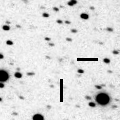
|
It was discovered in 1819, and re-discovered in 2003. Although it was predicted to be extremely faint as 26 mag, it unusually brightened up to 17.5 mag in outburst in 2013 July (July 6, Hidetaka Sato). However, no observations have been reported since mid July. It will pass the perihelion in 2014 August, and will approach to the sun down to 0.96 a.u. The brightness is predicted to be 23 mag at best. However, if the cometary activity continues, it may be observed brighter. Ken-ichi Kadota reported it was not detected, fainter than 16.3 mag, on May 21.
Date(TT) R.A. (2000) Decl. Delta r Elong. m1 Best Time(A, h)
Aug. 30 8 8.80 20 56.1 1.562 0.961 36 22.9 4:02 (256, 17)
Sept. 6 8 41.83 19 37.7 1.594 0.969 35 22.9 4:09 (257, 16)
|
|
![]()
 4P/Faye
4P/Faye 32P/Comas Sola
32P/Comas Sola 117P/Helin-Roman-Alu 1
117P/Helin-Roman-Alu 1 29P/Schwassmann-Wachmann 1
29P/Schwassmann-Wachmann 1 C/2013 UQ4 ( Catalina )
C/2013 UQ4 ( Catalina ) C/2010 S1 ( LINEAR )
C/2010 S1 ( LINEAR ) C/2014 Q2 ( Lovejoy )
C/2014 Q2 ( Lovejoy ) P/2014 L2 ( NEOWISE )
P/2014 L2 ( NEOWISE ) C/2011 J2 ( LINEAR )
C/2011 J2 ( LINEAR ) C/2013 US10 ( Catalina )
C/2013 US10 ( Catalina ) C/2012 F3 ( PanSTARRS )
C/2012 F3 ( PanSTARRS ) C/2013 R1 ( Lovejoy )
C/2013 R1 ( Lovejoy ) 17P/Holmes
17P/Holmes C/2006 S3 ( LONEOS )
C/2006 S3 ( LONEOS ) C/2014 N3 ( NEOWISE )
C/2014 N3 ( NEOWISE ) (596) Scheila
(596) Scheila 134P/Kowal-Vavrova
134P/Kowal-Vavrova 284P/2013 J1 ( McNaught )
284P/2013 J1 ( McNaught ) C/2013 Y2 ( PanSTARRS )
C/2013 Y2 ( PanSTARRS ) 108P/Ciffreo
108P/Ciffreo 106P/Schuster
106P/Schuster C/2013 V1 ( Boattini )
C/2013 V1 ( Boattini ) 16P/Brooks 2
16P/Brooks 2 C/2011 KP36 ( Spacewatch )
C/2011 KP36 ( Spacewatch ) C/2014 A4 ( SONEAR )
C/2014 A4 ( SONEAR ) C/2014 Q3 ( Borisov )
C/2014 Q3 ( Borisov ) C/2013 V4 ( Catalina )
C/2013 V4 ( Catalina ) 246P/2010 V2 ( NEAT )
246P/2010 V2 ( NEAT ) P/2012 B1 ( PanSTARRS )
P/2012 B1 ( PanSTARRS ) C/2009 F4 ( McNaught )
C/2009 F4 ( McNaught ) C/2013 G3 ( PanSTARRS )
C/2013 G3 ( PanSTARRS ) 44P/Reinmuth 2
44P/Reinmuth 2 C/2014 Q1 ( PanSTARRS )
C/2014 Q1 ( PanSTARRS ) C/2012 K8 ( Lemmon )
C/2012 K8 ( Lemmon ) 304P/2014 L4 ( Ory )
304P/2014 L4 ( Ory ) 174P/(60558) 2000 EC98 ( Echeclus )
174P/(60558) 2000 EC98 ( Echeclus ) 191P/McNaught
191P/McNaught 201P/LONEOS
201P/LONEOS 110P/Hartley 3
110P/Hartley 3 303P/2014 L1 ( NEAT )
303P/2014 L1 ( NEAT ) C/2010 U3 ( Boattini )
C/2010 U3 ( Boattini ) P/2005 L1 ( McNaught )
P/2005 L1 ( McNaught ) 11P/Tempel-Swift-LINEAR
11P/Tempel-Swift-LINEAR 19P/Borrelly
19P/Borrelly 280P/2013 C1 ( Larsen )
280P/2013 C1 ( Larsen ) 289P/Blanpain
289P/Blanpain![]()







































